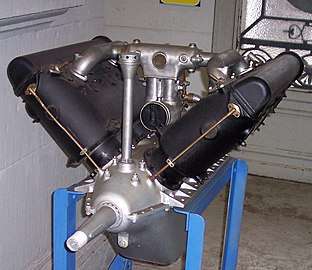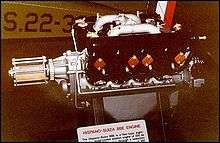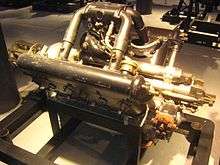Hispano-Suiza 8
The Hispano-Suiza 8 was a water-cooled V8 SOHC aero engine introduced by Hispano-Suiza in 1914, and was the most commonly used liquid-cooled engine in the aircraft of the Entente Powers during the First World War. The original Hispano-Suiza 8A was rated at 140 hp (100 kW) and the later, larger displacement Hispano-Suiza 8F reached 330 hp (250 kW).
| Hispano-Suiza 8 | |
|---|---|
 | |
| Preserved "direct-drive" Hispano-Suiza 8 | |
| Type | V8 piston engine |
| Manufacturer | Hispano-Suiza |
| First run | 1914 |
| Number built | 49,800 |
| Variants | Wolseley Viper |
Hispano-Suiza 8 engines and variants produced by Hispano-Suiza and other companies under licence were built in twenty-one factories in Spain, France, Britain, Italy, and the U.S.[1] Derivatives of the engine were also used abroad to power numerous aircraft types and the engine can be considered as the ancestor of another successful engine by the same designer, the Hispano-Suiza 12Y (and Soviet Klimov V12 derivative aero-engines) which was in service during the Second World War.
Design and development
Origins
At the beginning of World War I, the production lines of the Barcelona based Hispano-Suiza automobile and engine company were switched to the production of war materiel. Chief engineer Marc Birkigt led work on an aircraft engine based on his successful V8 automobile engine.[2] The resulting engine, called the Hispano-Suiza 8A (HS-31), made its first appearance in February 1915.
The first 8A kept the standard configuration of Birkigt's existing design: eight cylinders in 90° Vee configuration, a displacement of 11.76 litres (717.8 cu in) and a power output of 140 hp at 1,900 rpm. In spite of the similarities with the original design, the engine had been substantially refined. The crankshaft was machined from a solid piece of steel. The cylinder blocks were cast aluminium and of monobloc type that is, in one piece with the SOHC cylinder heads. The inlet and exhaust ports were cast into the blocks, the valve seats were in the top face of the steel cylinder liners, which were screwed into the blocks. Using a rotating bevel gear-driven tower shaft coming up from the crankcase along the rear end of each cylinder bank, with the final drive for each cylinder bank's camshaft accommodated within a semicircular bulge at the rear end of each valve cover. Aluminium parts were coated in vitreous enamel to reduce leakage. All parts subject to wear, and those critical for engine ignition were duplicated: spark plugs for dual ignition reliability, valve springs, magnetos, etc.
Engine reliability and power to weight ratios were major problems in early aviation. The engine and its accessories weighed 185 kg (408 lb), making it 40% lighter than a rotary engine of equivalent power. This empty weight does not include the radiator and coolant fluid. Generally, air-cooled engines are lighter than their equivalent horsepower water-cooled counterparts. For example, the Bentley BR.2 rotary put out 230 hp (170 kW) and weighed 220 kg (490 lb), Clerget 9B rotary 130 hp (97 kW), 173 kg (381 lb). The new engine was presented to the French Ministry of War in February 1915, and tested for 15 hours at full power. This was standard procedure for a new engine design to be admitted into military service. However, because of lobbying by French engine manufacturers, the Spanish-made engine was ordered to undergo a bench test that no French-made engine had yet passed: a 50-hour run at full speed. The HS-31 was therefore sent back to Chalais-Meudon on July 21, 1915, and tested for 50 hours, succeeding against all expectations. The design also promised far more development-potential than rotary engines. This was despite being the most common type, then in use, for most aircraft. Also, rotary engines were getting close to the limits of their development at this time. Rotary engines of increased power generally had increased weight, which in turn increased the already serious gyroscopic torque generated by the engine's rotation. A further increase in torque was considered unacceptable, and the power to weight ratio of the new rotary engines under development did not appeal to aircraft designers.
French officials ordered production of the 8A to be started as soon as possible and issued a requirement for a new single-seat high-performance fighter aircraft using the new engine. The Louis Béchereau-designed SPAD VII was the result of this requirement and allowed the Allies to regain air superiority over the Germans.
Variants
Some data from: British Piston Engines and their Aircraft[3]
Note: Hispano-Suiza company type numbers were prefixed by HS- or written in full as Hispano-Suiza Type 31, but military designations used the conventional system of Hispano-Suiza(engine manufacturer) 8(no of cylinders) A(engine series) b(variant) r(attribute), thus Hispano-Suiza 8Abr.
- 8 (HS-31)
- 100 kW (140 hp), initial production and test engines, with few applications, including early Nieuport 14s.
- 8Aa (HS-31)
- 110 kW (150 hp) at 2000 rpm, entered production in July 1915. Early HS-8A engines were plagued with various problems which required further work and was the standard powerplant for early-production SPAD VIIs. The demand for the Hispano-Suiza engine was such that other manufacturers began producing it under licence, in France, Great Britain (Wolseley Adder), Italy (Nagliati in Florence and Itala/SCAT (automobile) in Turin) and Russia. Total production of the HS-8Aa amounted to some 6,000 engines.
- 8Ab (HS-34)
- 130 kW (180 hp) at 2,100 rpm, increasing the compression ratio from 4.7 to 5.3, Birkigt was able to increase the power output . The 8Ab began replacing the 8Aa on SPAD VIIs in early 1917.
- 8Ac
- 8Ad
- (1929) 120 mm × 130 mm (4.7 in × 5.1 in) bore x stroke, 160 kW (210 hp) for take-off.[4]

- 8B (HS-35)
- 150 kW (200 hp), compression ratio 5.3:1, geared at 0.75:1. The HS-36 was the 8B with a Lewis gun firing through the propeller boss.
- 8B twin (HS-39)
- Coupled 8B engines
- 8Ba
- 150 kW (200 hp) at 2,300 rpm, low compression ratio of 4.7:1, spur geared at 0.585:1.
- 8Bb
- 150 kW (200 hp), compression ratio of 4.8:1, reduction gear 0.75:1. However the reduction gear system was fragile, and often broke down, sometimes with spectacular results ending up with the entire propeller, driveshaft and driven gear parting company from the airframe. Progressive refinement of the engine brought the available power to 175 kW (235 hp) by the end of 1917.
The 8B series was used to power the earliest versions of the S.E.5a, all examples of the SPAD S.XIII, front-line versions of the Sopwith Dolphin and several other Allied aircraft types, with its gear reduction easily identifiable in vintage World War I photos, from its use of a clockwise (viewed from in front, otherwise known as a left hand tractor) rotation propeller.
- 8Bc
- 160 kW (220 hp), compression ratio of 5.3:1, reduction gear 0.75:1.
- 8Bd
- 160 kW (220 hp), compression ratio of 5.3:1, reduction gear 0.75:1.
- 8Bda
- 8Be
- 160 kW (220 hp), compression ratio of 5.3:1, reduction gear 0.75:1.
- 8BeC (HS-38)
- The 8Be fitted with the 37 mm (1.457 in) SAMC Model 37 cannon, or a similar weapon, firing through the propeller boss. A reduction gear equipped power-plant with a resultant clockwise rotation propeller like the 8B, produced 160 kW (220 hp) at 2,100 rpm. Two known weapons fitted were the SAMC with a rifled barrel and a smooth-bore cannon firing canister ammunition. The moteur-canon could fire a single shot at a time through the hollow drive shaft without propeller interference. This cannon mount required an "elevated" intake manifold design, bringing the intake "runners" straight off the inner surfaces of the cylinder banks to the updraft carburetor's plenum chamber. The engine was used on the SPAD S.XII.[5]
Note: The designations 8C, 8Ca, and 8Cb are probably contractions of the real STAe designation which would be similar to 8BeC or 8BeCa. Cannon-equipped 160 kW (220 hp) 8s were given the company designation HS-38

- Hispano-Suiza Type 40
- (8E ?)
- Hispano-Suiza Type 41
- (8A ?)
- 8F (HS-42)
- 220 kW (300 hp) at 2,100 rpm (eq. 750 lb·ft torque). The direct drive 8F was basically a bored out version of the 8B, intended for use in bombers, with a displacement of 18.5 l (1,128.94 cu in). Despite the increased weight of 564 lb (256 kg), the 8F was also installed in fighters such as the Nieuport-Delage NiD 29 and Martinsyde Buzzard, and would have powered the never-produced Mk.II version of the Sopwith Dolphin. Engine speed being lower than that of the HS-8B, the reduction gear was deleted, thereby increasing engine reliability.
- 8Fa
- generally similar to the 8F.
- 8Fb
- 220 kW (300 hp), aka HS Type 42, compression ratio of 5.3:1, direct drive.
- 8Fd Special
- For the CAMS 38 Schneider Trophy racer developing 280 kW (380 hp)
- 8Fe (HS-42VS)
- (1926) 140 mm × 150 mm (5.5 in × 5.9 in) bore x stroke, 260 kW (350 hp) for take-off.[4]
- Wolseley W.4A Python I
- 110 kW (150 hp), compression ratio of 4.7:1. License production of the 8Aa at Wolseley Motors Ltd.
- Wolseley W.4A Python II
- 130 kW (180 hp), compression ratio of 5.3 :1.
- Wolseley W.4A Viper
- 150 kW (200 hp), compression ratio of 5.3 :1. Wolseley's engineers removed problems with the crankshaft and increased the compression ratio to give more power, with some early engines having a compression ratio of 5.6:1.
- Wolseley W.4A Viper II
- 160 kW (210 hp) at 2,000 rpm.[6]
- Wolseley W.4B Adder I
- 150 kW (200 hp), compression ratio of 4.7 :1, reduction spur gear to 0.593:1.
- Wolseley W.4B Adder II
- 150 kW (200 hp), compression ratio of 4.7 :1, reduction spur gear to 0.593:1. With stronger crankshaft webs.
- Wolseley W.4B Adder III
- 150 kW (200 hp), compression ratio of 4.7 :1, reduction spur gear to 0.593:1. With balanced crankshafts.
- Wright-Hisso A
- [7]
- Wright-Hisso B
- 4-cyl in-line water-cooled 56 kW (75 hp) 120 mm × 130 mm (4.7 in × 5.1 in)[7]
- Wright-Hisso C
- 150 kW (200 hp) geared A[7]
- Wright-Hisso D
- 150 kW (200 hp) geared A with cannon[7]
- Wright-Hisso E
- 130 kW (180 hp) (HC 'I'[7]
- Wright-Hisso E-2
- (HC 'E')[7]
- Wright-Hisso F
- ('D' without cannon)[7]
- Wright-Hisso H
- 220 kW (300 hp)[7]
- Wright-Hisso H-2
- improved 'H'[7]
- Wright-Hisso I
- [7]
- Wright-Hisso K
- H with 37mm Baldwin cannon[7]
- Wright-Hisso K-2
- [7]
- Wright-Hisso M
- experimental 300hp[7]
- Wright-Hisso T
- Wright-Hisso 180hp V-8
- direct drive
- Wright-Hisso 220hp V-8
- geared drive
- Wright-Hisso 300hp V-8
- geared drive
- M-6
- A 220 kW (300 hp) Soviet Union produced copy of the 8Fb
- Wright-Hisso V-720
Applications
- Austin-Ball A.F.B.1 (single prototype)
- Avia BH-21 (from 1925)
- Avia BH-22
- Bartel BM-5
- Bernard SIMB AB 10
- Blanchard Brd.1
- Caudron R.11 (8Bba)
- Caudron C.59
- Caudron C.61 (8Ac)
- Curtiss JN-4H Jenny (rare subvariant)
- De Bruyère C 1
- Descamps 27 (8Fb)
- Dewoitine D.1 (8Fb)
- Farman F.121 Jabiru (8Ac)
- FBA Type H (8Aa)
- Felixstowe F.1
- Fokker D.IX
- Fokker D.X (8Fb)
- Fokker D.XII (8F) initial design only
- Fokker S.III
- Gourdou-Leseurre GL.21
- Hanriot HD.5
- Hanriot HD.15
- Hanriot HD.20
- Letord Let.1 (8A)
- Letord Let.2 & Let.3 (8Ba)
- Letov Š-7 (8Fb)
- Letov Š-13 (8Fb)
- Letov Š-14 (8Fb)
- Levasseur PL.1 (8Ab)
- Martinsyde F.4 Buzzard (8Fb)
- Nieuport 14 (8A)
- Nieuport-Delage NiD 29 (8Fb)
- Nieuport-Delage NiD 38 (8Ab)
- Nieuport-Delage Sesquiplan (8Fb)
- Royal Aircraft Factory S.E.5 and S.E.5a (8a, 8B on early versions, and the Wolseley Viper derivative),
- Sopwith Dolphin (8B)
- Sopwith B.I prototypes (8Ba)
- SPAD S.VII (8A)
- SPAD S.XI (8Be)
- SPAD S.XII (8Cb)
- SPAD S.XIII (8Be)
- Standard J-1 (post-war modification)
- Waco DSO (8a)
- Wibault 1 (single prototype)
Wright-Hispano E
- Boeing NB-2
- AT-3
- Consolidated PT-1
- Cox-Klemin TW-2
- Curtiss AT-4
- Dayton-Wright TW-3
- Huff-Daland TW-5
- Loening M-8
- Travel Air 3000
- Vought VE-7
- Waco DSO
Mitsubishi "Hi"shiki
- 200 HP (8B)
- Yokosuka Ro-go Ko-gata
- Hanza-shiki suijō teisatsuki (ハンザ式水上偵察機, Type Hansa Surveillance Floatplane)
- 300 HP (8F)
Comparative table
| Model | 8A | 8Aa | 8Ab | 8B | 8F |
|---|---|---|---|---|---|
| Bore (mm) | 120 | 140 | |||
| Stroke (mm) | 130 | 150 | |||
| Displacement (l) | 11.76 | 11.76 | 18.47 | ||
| Compression ratio | 4.7 | 5.3 | |||
| Length (m) | 1.19 | 1.25 | 1.31 | 1.36 | 1.32 |
| Width (m) | 0.81 | 0.83 | 0.85 | 0.86 | 0.89 |
| Height (m) | 0.77 | 0.81 | 0.87 | 0.90 | 0.88 |
| Weight(kg) | 195 | 215 | 230 | 236 | 256 |
| Power output (hp) | 140 | 150 | 180 | 200/235 | 300 |
| at (rpm) | 1900 | 2000 | 2100 | 2300 | 2100 |
Engines on display
- A Wright-Hisso 8A is on public display at the Aerospace Museum of California.
Specifications (Hispano-Suiza 8a)
General characteristics
- Type: 8-cylinder liquid-cooled Vee piston engine
- Bore: 120 mm (4.724 in)
- Stroke: 130 mm (5.118 in)
- Displacement: 11.76 L (717.77 in3)
- Dry weight: 202 kg (445 lb)
Components
- Valvetrain: SOHC (single overhead cam)
- Fuel system: 1 Claudel or Zenith Carburetor
- Cooling system: liquid
Performance
- Power output: 150 hp (112 kW) at 1,700 rpm
- Fuel consumption: 310 g/(kW•h) (0.51 lb/(hp•h))
- Oil consumption: 18.2 g/(kW•h) (0.03 lb/(hp•h))
See also
Related development
- Harkness Hornet, a single bank of the Hispano-Suiza, on an Australian-made crankcase.
- Wolseley Viper
Comparable engines
Related lists
References
- Browne, T.C. "Retrospect: 1924 Hispano-Suiza H6c Speedster", Motor Trend, 4/84, p.118.
- One prototype of this aircraft engine is preserved in the "Museo de Aeronáutica y Astronáutica" in Madrid.
- Lumsden, Alec (2003). British Piston Engines and their Aircraft. Marlborough, Wiltshire: Airlife Publishing. ISBN 1-85310-294-6.
- Moteurs d'Aviation Hispano-Suiza (PDF) (in French). Boix-Colombes: Société Française Hispano-Suiza. 1932. Archived from the original (PDF) on 2015-07-25.
- "V-8, Hispano-Suiza Model 8 Ca". Retrieved 24 October 2010.
- http://www.flightglobal.com/pdfarchive/view/1919/1919%20-%200199.html Flight February 13, 1919 p 199
- Angle, Glenn D. (1921). Airplane Engine Encyclopedia. Dayton, Ohio: THE OTTERBEIN PRESS.
- Janes Fighting Aircraft of World War I by Michael John Haddrick Taylor (Random House Group Ltd. 20 Vauxhall Bridge Road, London SW1V 2SA, 2001, ISBN 1-85170-347-0), page 289
- Hartmann, Gérard (December 2005). "Le V8 Hispano-Suiza" (PDF) (in French). pp. 6 pages.
- "Los motores V8 de aviación de La Hispano Suiza (1914-1918)" by Jacinto García Barbero (Edited by Asociación de Amigos del Museo Del Aire, Museo de Aeronáutica y Astronáutica, CECAF. Depósito legal: M-41737-2005) 219 pages.
External links
| Wikimedia Commons has media related to Hispano-Suiza 8. |